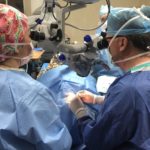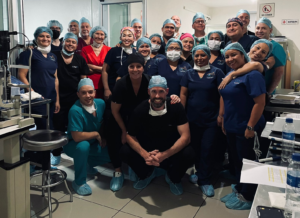
Cells from Two Donors Treated 50 Patients with Corneal Endothelial Disease
July 25, 2021 – Seattle, Boston and Tokyo – Aurion Biotech, whose mission is to cure blindness by developing a differentiated platform of advanced therapies to treat ocular diseases, today announced preliminary findings from its IOTA trial, conducted in November 2020 and in May of this year, at the Clínica Quesada in San Salvador, El Salvador.
In the IOTA trial, 50 patients diagnosed with corneal endothelial disease were treated with a transformational cell therapy procedure first developed by Professor Shigeru Kinoshita and colleagues at Kyoto Prefecture University of Medicine (KPUM). The IOTA trial is the first corneal endothelial cell therapy procedure to be performed successfully outside of Japan, with Drs. Gabriel and Rodrigo Quesada, and U.S. surgeons Drs. Edward Holland, Elizabeth Yeu, John Berdahl, Matt Giegengack, John Vukich and Kevin Waltz participating as investigators.
“This is a landmark moment for the treatment of corneal endothelial disease,” declared Dr. Holland, chief medical advisor and medical advisory board chair at Aurion Biotech. “We achieved what we set out to accomplish: in IOTA-Part 1, we were able to treat 16 patients from a single donor. In IOTA- Part 2, we treated 34 patients from a single donor. Equally important: we confirmed that this procedure is accessible for surgeons and minimally invasive for patients. The initial readout from this proof-of-concept trial is promising: patients have demonstrated improvements in visual acuity and central corneal thickness. We will continue to monitor these patients over time, to assess the safety and efficacy of the cell therapy treatment.”
The IOTA trial was conducted as a proof of concept of previous studies of the cell therapy procedure developed by Professor Kinoshita and his KPUM colleagues.
“The IOTA trial has given us invaluable clinical insights and confirms that this procedure can restore vision to patients suffering from blindness resulting from corneal endothelial disease,” said Greg Kunst, Aurion Biotech’s chief executive officer. “Until Professor Kinoshita’s astonishing innovations in corneal endothelial cell therapy, vision loss caused by corneal edema has remained largely underserved. That’s because of a chronic undersupply of donor corneas and current standards of care that involve exceptionally complex procedures. Because we have acquired this intellectual property, we look forward to advancing this cell therapy through regulatory approval in the US and elsewhere, to restore vision to patients throughout the world.”
Patients in the IOTA trial will be assessed periodically over twelve months according to protocol guidelines and beyond conclusion of the trial, to monitor safety and efficacy of treatment. Aurion Biotech intends to publish key findings in the future, in order to contribute to a greater medical and scientific understanding of corneal endothelial cell therapy.
About Corneal Endothelial Disease
Corneal edema is a serious, sight-threatening and debilitating condition affecting millions of people throughout the world. When corneal endothelial cells die or degrade, they do not regenerate. Ultimately, corneal endothelial cell loss can cause corneal edema and loss of vision. Although corneal transplants are effective, there are disadvantages with these procedures (DMEK/DSAEK[1]):
-
Limited donor organ supply. Transplants require a supply of donor corneas in a 1:1 ratio (one healthy donor cornea to treat each diseased one). However, it’s estimated that there is only one donor cornea available for every 70 diseased eyes.[2]
-
Complex surgical procedure. Although there are approximately 20,000 ophthalmologists in the US[3], and approximately 1,500 corneal specialists, it’s estimated that fewer than 300 actively perform the DMEK/DSAEK procedures. While DMEK has excellent outcomes, it’s estimated that up to 25% of patients undergoing DSAEK may require a regraft procedure[4].
About Corneal Endothelial Cell Therapy
The innovation from Professor Kinoshita/KPUM was to successfully propagate corneal endothelial cells in vitro, in order to inject healthy cells into the cornea, reduce corneal edema and restore vision. The safety, tolerability, and efficacy of this cell therapy is supported by clinical trials conducted in Japan. Compared to current standard of care, corneal endothelial cell therapy has several potential advantages:
-
Abundant supply of corneal endothelial cells. At present, the endothelial cells from one donor can replicate to treat up to 100 eyes.
-
Straightforward procedure to perform. The cell therapy procedure can be performed relatively quickly and is less complex than DMEK / DSAEK procedures.
-
Patient-friendly procedure. Post-operative recovery for cell therapy is several hours, as compared to several days for DSAEK/DMEK procedures.
About Aurion Biotech
Based in Seattle, Boston and Tokyo, Aurion Biotech is a clinical stage biotech company. Our mission is to cure leading forms of blindness and transform the lives of millions of patients, by developing a platform of advanced therapies to treat ocular diseases. Our first candidate is for the treatment of corneal edema, and one of the first clinically validated cell therapies for corneal care. Healthy cells from a donor cornea are cultured in a novel, multi-step, proprietary and patented process. Cells from a single donor can be used to treat more than 100 recipient eyes. In clinical trials in Japan, patients have experienced significant and durable improvements in key measures of corneal health: visual acuity, corneal endothelial cell density and corneal thickness. The Aurion Biotech team is preparing for clinical trials in the U.S. To learn more about Aurion Biotech, a division of CorneaGen Inc., visit www.aurionbiotech.com
[1] Descemets Membrane Endothelial Keratoplasty, Descemet Stripping Automated Endothelial Keratoplasty
[3] https://www.aao.org/newsroom/eye-health-statistics#ophthalmologists
[4] Source: EBAA 2020 Annual Report
Media Contacts:
|
Judith McGarry 415-971-2900 |
Michele Gray 917-449-9250 |

Q&A With Eris Jordan, VP Clinical and Medical Affairs
We sat down with Eris Jordan, to hear the story-behind-the-story of Aurion Biotech’s announcement of its IOTA trial in corneal endothelial cell therapy
Q: Thank you for taking time to speak with us.
EJ: I’m delighted to do so.
Q: First off, why did Aurion Biotech conduct a clinical trial in El Salvador?
EJ: We chose El Salvador and Clínica Quesada for multiple reasons. Clínica Quesada has an excellent reputation for high-quality patient care. I’ve had the pleasure of working with Drs. Gabriel and Rodrigo Quesada and their terrific staff on previous projects and they consistently deliver exceptional service to their patients. The geographic proximity of this clinic to the US makes it easy for our US surgeons to travel there to perform the procedures and continue close follow-up care of patients. In this effort, we’ve established a good working relationship with the El Salvadoran Institutional Review Board and Ethics Committee. Professor Kinoshita and his team’s extensive work provided a solid foundation for the government to welcome this project.
Q: What did you hope to learn?
EJ: Having acquired the IP from Professor Kinoshita, we felt it was important to conduct a proof-of-concept trial outside of Japan, with US surgeons as lead investigators, and with non-Japanese patients. Although Professor Kinoshita remains a key contributor to our clinical development and is a member on our Medical Advisory Board, the COVID-19 pandemic has made in-person collaboration nearly impossible. So, initiating this trial made sense. You could say that our goals were modest: can we do this? I’m happy today to answer that question: yes, we can.
Q: Why in November of 2020?
EJ: It was a good time for Clínica Quesada, and it was a good time for our surgeons. It was certainly not a good time for weather conditions. On the day we were supposed to depart for El Salvador, a Category 4 hurricane was barreling down on Central America. We had an emergency conference call, looked at the weather forecasts and conditions, said a prayer to the weather gods, and decided to go for it. The team was unanimous in their desire to brave the hurricane – amid a global pandemic! – to treat the patients we had lined up. It was truly a humbling moment for me, and for all of us at Aurion Biotech.
Q: Wow! That takes determination. And a leap of faith.
EJ: GRIT! Fitting, as grit is one of our core values (the others are stewardship and transformation). We felt we had an obligation to treat patients (that’s where stewardship comes in). We had worked for months to line up schedules and we really, really wanted to move forward. It’s because we believe this procedure has the potential to transform patient care in this indication. So, we did move forward. Fortunately, the hurricane didn’t foil our plans: air travel continued and the entire team made it to San Salvador. Every single patient was able to get to the clinic for treatment. Amazingly, we pulled it off.
Q: How do you know this cell therapy procedure works? What do you actually measure? What’s considered healthy?
EJ: Professor Kinoshita’s extensive research and clinical trials with 65 patients have validated this procedure. Efficacy and safety data have been published in New England Journal of Medicine[1], and in Ophthalmology Journal[2]. Our job was to try and do exactly what he and his team did, and that includes the assessments. We examine corneal clarity using a slit lamp. Pre-op, we look for signs of corneal endothelial dysfunction (a “cloudy” cornea). Post-op, we hope to see a clear cornea. We also take quantitative measures, such as central corneal thickness (expressed in microns, or µ); 540 – 560 microns is considered average. We assess best corrected visual acuity (BCVA) using the Snellen scale, and a healthy range is 20/20 – 20/40. We also count endothelial cell density or ECD, (expressed as cells/mm2); a healthy range for ECD is somewhat age-related: healthy eyes aged 50+ measure in the 1,500 – 2,000 cells/mm2 range.
Q: When will you share data from the Iota clinical trial?
EJ: We hope to publish key findings once we have sufficient time to analyze the data. Keep in mind that IOTA-Part 1 commenced last November (2020). For patients treated in IOTA-Part 2 in May 2021, we are just beginning assessments. So far, we are pleased with initial findings but want to be sure that our analysis is thorough, and that we track patients over the next twelve months and beyond.
Q: One last question: why did you name this trial IOTA? I checked that word definition: it means “small” or “jot.” Yet this seems like a very significant effort.
EJ: Well, our unofficial fourth core value is humor. So, we named the trial in honor of that Category 4 hurricane, since it nearly ruined our best-laid plans! Also it’s a propos (if unintentional): small can be mighty. Our small, healthy, tightly-packed corneal endothelial cells can deliver mighty results in vivo.
[1] New England Journal of Medicine: March 2018
[2] AAO Ophthalmology Journal: 2020